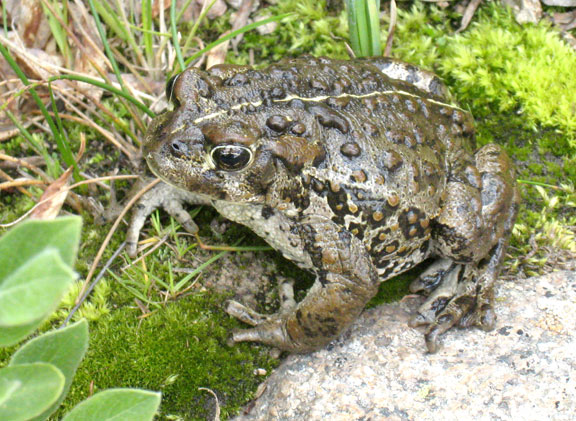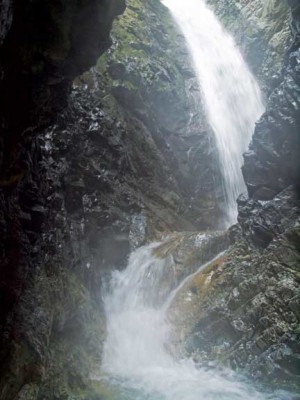By Daniel Smith
It’s the amphibian of your youth.
Brown, squat, lumpy with “warts” – the kind your mother warned you about. The Boreal Toad (Anaxyrus Boreas) is the quintessential toad in appearance.
The little four-inch toad is the focus of an important preservation campaign in Chaffee County, which has one of the few isolated areas in the world where it may have a chance to hold its own. But now the extinction threat is real, even here.
The chytrid fungus, a disease thought to have originated in Africa, is an extinction threat. Globally, amphibian numbers have declined alarmingly, accelerating since the end of the last century.
The Boreal Toad was very common in high, wet areas of the Colorado mountains, but by 1989, surveys found an 83 percent population loss from breeding areas.
Beginning in 1994, population surveys were done in some of the habitat where they were quickly disappearing, and a multi-agency rescue effort started not long after. The Boreal Toad is now listed as endangered in Colorado and New Mexico and as a protected species in Wyoming. A decision on its listing as endangered by the U.S. Fish and Wildlife Service is pending in 2017.
“It’s tough being a toad,” says Stephanie Shively, a U.S. Forest Service Salida District wildlife biologist, who made a presentation earlier this year to the Central Colorado Humanists on the amphibian and the threats it faces.
“The species has a pretty rough life, really,” she said.
In addition to the deadly fungus, these high elevation toads face a 95 percent mortality rate for offspring, habitat destruction, threats from high-altitude weather and predation. Still, the Chaffee County populations were a stronghold, but are now threatened.
[InContentAdTwo]
Wetland breeding areas around Cottonwood Lake and Creek in Chaffee County had been previously unaffected by the parasitic fungus. Sadly, more recent studies confirmed the fungus is now in the Cottonwood drainage.
“Last summer it was confirmed, and this summer we’re seeing the impacts on the adults – they’re not returning back in the numbers that they have previously,” Shively said.
Worse yet, because that drainage area had been free of the fungus, eggs from there were being used in a program to breed chytrid-free toads in a San Luis Valley facility to transplant into areas with depleted populations; now, that won’t be possible.
There is no cure for the fungus, which infects the toad’s skin and causes an electrolyte disfunction affecting the heart that can kill in a matter of weeks. There is no accurate way to determine where the fungus lingers in the environment yet, and there is some evidence that it can be carried into an uninfected area by humans and other species.
Why care about a toad species? For the same reason accelerating species extinctions everywhere are important, experts tell us – they represent an ecological imbalance that can have large impacts on the human environment as well.
Nature is interconnected, period.
Shively and other agencies cooperated in a July effort to protect toad habitat in the Cottonwood Pass drainage. A Southwest Conservation Corps (SCC) crew, paid for by a Colorado Parks and Wildlife wetlands funding program, worked over five days, rehabilitating an old trail within the Buffalo Peaks Wilderness. Fourmile Creek Trail was rerouted away from the sensitive areas. Camping sites were moved as well. The role of groups like the SCC and the Colorado Mountain Club volunteers was invaluable.
“We encourage the public to disperse camp on the uphill side of the road, away from the stream, to prevent the further spread of chytrid fungus to other neighboring drainages,” Shively said.
“We are also recommending the public disinfects all their fishing gear, waders, boots, etc. after getting them wet in the beaver ponds or creek before fishing in another drainage. The simplest solution is 10 percent bleach and water,” she added.
Research into understanding the toad itself and the disease is critical, says Paul Foutz, Colorado Parks and Wildlife aquatic conservation biologist, who said the appearance of the fungus in the previously unaffected Cottonwood drainage last year was obviously ‘alarming.’
But what’s definitely bad news for the little toad locally will hopefully help scientists’ understanding.
“From that perspective, Chaffee County and toads in the Cottonwood drainage will hopefully provide some insights into how chytrid impacts a population,” Foutz said.
“If there are any positives that could come out of that – if we do see a decline in that population – it’s better understanding maybe how that works in concert with all the research we have going on there,” he added.
Brad Lambert, research zoologist with the Colorado Natural Heritage Program with CSU says Chaffee County has had a history of strong populations of the toad, including reports of them gathering under street lights in town as far back as 1914.
Lambert notes that important research is trying to unravel mysteries such as why some other amphibians, such as salamanders and even bullfrogs, may carry the fungus but aren’t affected as much as toads.
“It’s extremely challenging to learn more about how it’s spread and how it even exists in the landscape,” he said.
In addition to the statewide recovery effort, an Arkansas Basin Boreal Toad group meets regularly to coordinate activities and efforts, including comparing surveys, seeking potential sites for reestablishment efforts and more. It includes representatives of CPW, U.S. Forest Service, BLM, the Colorado Natural Heritage Program at CSU and others.
What can we do? Besides becoming educated about threats to locally unique species like the Boreal Toad, keep an eye out for them. You can report Boreal Toad and tadpole sightings to the CPW – it’ll help research.
Above all, experts urge – leave them alone.
Give the little guy a fighting chance.
Dan Smith is a retired Denver Post and network radio journalist who rejected the federal witness protection program in favor of mountain bliss in Salida.



